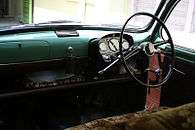Premier Padmini
| Premier Padmini | |
|---|---|
 | |
| Overview | |
| Manufacturer | Premier Automobiles |
| Also called |
Fiat 1100 Delight Premier President |
| Body and chassis | |
| Class | City car |
| Body style | 4-door saloon |
| Layout | FR layout |
| Related | Fiat 1100D |
| Powertrain | |
| Engine | 1,089 cc Fiat 103 I4 . 1,366 cc "PAD 137N" naturally aspirated . 1,089 cc "S1". |
| Transmission | 4-speed manual. |
| Dimensions | |
| Wheelbase | 2,340 mm (92 in) |
| Length | 3,905–3,940 mm (153.7–155.1 in) |
| Width | 1,460 mm (57 in) |
| Height | 1,470 mm (58 in)[1] |
| Chronology | |
| Predecessor | Fiat 1100 |
| Successor | Premier 118NE |
Premier Padmini is an automobile that was manufactured in India from 1973 to 1998 by Premier Automobiles Limited, a division of the Walchand Group, under license from Fiat and marketed initially as the Fiat 1100 Delight — and beginning in 1973 as the Premier Padmini. The Padmini's primary competitor in the Indian market was the Hindustan Ambassador and Standard Herald. This famous car[2] ruled the Indian car market and its popularity peaked during 1970s and 80s. Many leading icons of the time including [3] legendary Rajnikanth, Mammootty, Aamir Khan and many others had owned a Premier Padmini during its prime years. Known colloquially as the Pad,[4] or Fiat (since the Padmini was originally a Fiat car), the Padmini is named for a 14th-century Rajput princess.[4] Padmini translates to "she who sits on the lotus" and refers to the Goddess Lakshmi. It was also a common name for girls in India at the time.
The Fiat 1100D, based on the Fiat 1200 GranLuce Berlina, debuted in India in 1964 with a carburetted 1,089 cc four-cylinder petrol engine — rather than the 1,221 cc engine fitted to the GranLuce in Italy. With a 10.8:1 compression ratio, it created 47 bhp (35 kW) at 4,800 rpm with a maximum torque of 7.20 kg·m (71 N·m; 52 lb·ft) at 3,000 rpm. The original transmission was a four-speed manual gearbox (without synchronized first gear), which drove the rear wheels via a live rear axle. It had a column-mounted shifter, on the left-hand side of the steering column. Weighing 895 kg (1,973 lb) with that engine the car could attain a top speed of 130 km/h (81 mph).
Premier manufactured the Padmini at their Kurla plant in Bombay (now Mumbai) until they sold a majority stake to Fiat SpA in September 1997. The licensed vehicle was initially manufactured as the Fiat 1100 Delight. For model year 1972, the car was marketed as the Premier President and subsequently as the Premier Padmini. The car, in its peak during the 1970s-1980s, achieved immense popularity among youngsters, celebrities and women as compared to the Hindustan Ambassador, it looked more modern in appearance, more fuel-efficient and was very easy to drive.
By the early 1980s, engine power was reduced to 42 bhp with a modified carburettor to make it more fuel efficient 42 bhp (31 kW) at 5,000 rpm. Premier began to offer an air-conditioning system, leather upholstery, courtesy lights and tinted glasses in the Padmini. These were considered luxuries in Indian cars at the time.
From the mid 1980s onward, with the advent of more modern, cheaper and more fuel-efficient cars from Maruti Suzuki, the popularity of the Padmini slowly began to wane. The liberalisation of the Indian economy in 1991, which allowed foreign car manufacturers to launch operations in India, began to sound the death knell for the Padmini. The Padmini was never able to compete with the more modern, value-for-money and fuel-efficient cars manufactured by Ford, General Motors, Daewoo, Honda and Hyundai. In 1996, Premier tried to revive the sagging fortunes of the Padmini by introducing a more modern variant. Named as the Padmini S1, this variant had a more modern radiator grille, bucket seats, a Nissan floor-shift synchronised Nissan gearbox and a more powerful engine thanks to employing a Solex carburetor and use of a thermostat-controlled electric fan with an output of 48 bhp (36 kW) of horsepower. A diesel variant, called the 137D was also introduced, with the hope of taking advantage of the rising popularity of diesel vehicles in India. Until then, the Padmini was only available with petrol engines.[5] The 137D had similar specs as that of the S1, the only difference lying in the engine, which was a diesel engine built under license from Fratelli Negri Macchine Diesel Sud (FNM), Italy, with a displacement of 1,366 cc and generating 45 bhp (34 kW). Its top speed was close to 140 kmph, and its fuel efficiency was 24 kmpl. Production was shut down only because of PAL's management problems.
Numerous examples still abound as taxicabs in Mumbai, though these are now being phased out due to new regulations enacted in 2013 by the government disallowing vehicles over 20 years old.[6] Many of these taxis now run on CNG for fuel economy.
While all cars built by Premier themselves were four-door sedans, small companies also offered other bodywork, mainly in the form of estates.[1] The Fiat 1100-D's original design remained unchanged, aside from some minor grill facelifts and the removal of the front-door quarter glass at some point in the 1980s.
| Premier Padmini Gallery | ||||||||
|---|---|---|---|---|---|---|---|---|
|
See also
References
- 1 2 Büschi, Hans-Ulrich, ed. (5 March 1987). Automobil Revue 1987 (in German and French). 82. Berne, Switzerland: Hallwag AG. p. 480. ISBN 3-444-00458-3.
- ↑ http://www.drivespark.com/four-wheelers/2014/a-tribute-to-the-premier-padmini-007886.html
- ↑ https://mostlyeconomics.wordpress.com/2015/01/23/history-of-indias-premier-padmini-fiat-car/
- 1 2 "Shedding Door Pulls, Mumbai Taxis Rattle Into History". The New York Times, DAVID SHAFTEL, December 28, 2012.
- ↑ "History of Premier Automobiles". Car History 4 U. Form and Function.
- ↑ "Mumbai's Premier Padmini taxis reach the end of the road". DNA India. 3 August 2013. Retrieved 15 August 2014.


